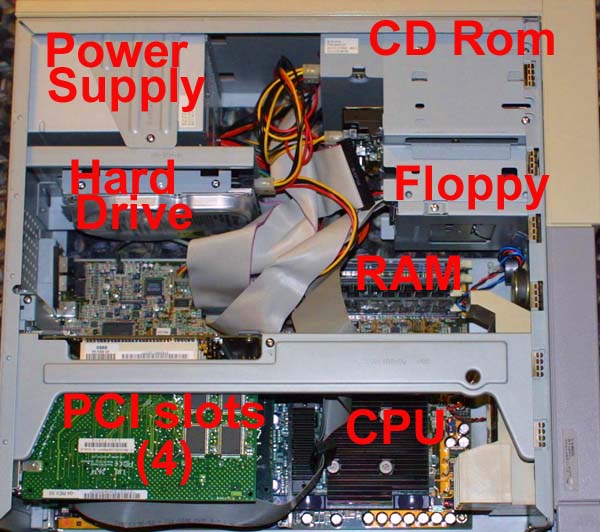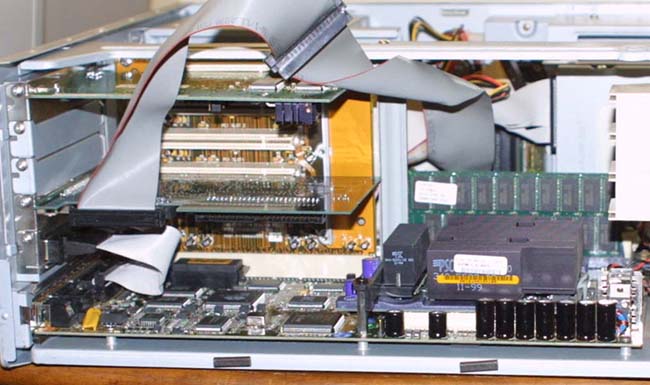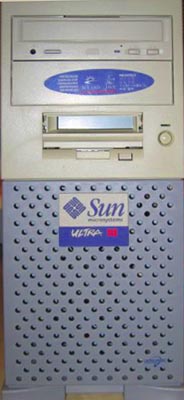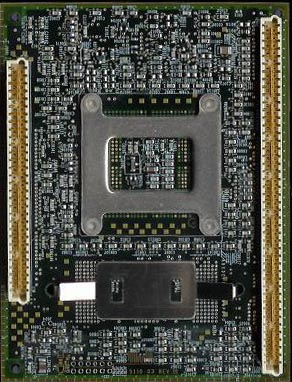| Unix, and the Ultra 10 | History and mods | The Sun 375-0095 | Solaris Links |
My first ever experience with Unix, was while working
for G.E. Medical. We had several Sun servers at G.E. Medical,
running our network, and these servers, along with several Sparc
stations; all ran Solaris. Most people consider Microsoft to have
a monopoly on operating systems, but on large computers, and servers
Microsoft has little presence. The dominant system in the server
and large computer world is an assortment of different flavors
of Unix, among them the Sun/Solaris version. This machine is my second
Solaris machine, but my first SPARC unit. My first Solaris machine
was based on a Pentium 2 unit, which runs a ported over, 32 bit version
of Solaris. SPARC is the 64 bit cpu which has been used in Sun servers
for years.
This is a Sun Ultra 10
computer. It is a tower machine, with four PCI slots, and will
take normal IDE drives, as well as a regular SVGA monitor, and
certain types of standard 168 pin ram. Traditionally, Sun machines
have used SCSI drives, Special memory, and special monitors. Sun equips
these Ultra Sparcs with 9 to 18 gb hard drives, but I used a 60gb,
and a 40gb for 100gb of storage. Though this is not my fastest machine,
it does use a 64 bit CPU with RISC architecture, so it is very likely
my most powerful machine. These machines have been out of production
since late 2002.
of standard 168 pin ram. Traditionally, Sun machines
have used SCSI drives, Special memory, and special monitors. Sun equips
these Ultra Sparcs with 9 to 18 gb hard drives, but I used a 60gb,
and a 40gb for 100gb of storage. Though this is not my fastest machine,
it does use a 64 bit CPU with RISC architecture, so it is very likely
my most powerful machine. These machines have been out of production
since late 2002.
I have installed the latest
version of the Sun operating system, Solaris 10. This is probably
the most popular version of Unix, and is a pretty standard operating
system in the server and mainframe world. Since I already have a
Solaris machine, though it is an Intel version, I am considering clustering
these machines.
The Ultra machines are beloved
of those who wish to use, and learn, genuine Unix, on a high level
platform. They are also held in derision by many Sun/Unix purists
as glorified PC class machines, or "Sparc Light" machines. Even so,
these machines have probably gone a long way towards increasing the viability
and longevity of Sun. With Windows making inroads in the server market,
Intel and AMD producing some 64 bit processors, and Linux enthusiasts
claiming their pet operating system to be the equal of real Unix, Sun
clearly needed to do something to break out of it's niche.
At their introduction, in the
mid to late nineties, these machines sold for several thousand dollars,
making them one of the great computer bargains of the day. At a current
market price of $100-$200 used (mid 2005), these machines continue
to be a bargain today. Sun is now offering it's excellent Solaris 10 operating
system for free to individual users, simply for signing a user agreement.
It is also possible to get the Star Office suite, as well as a good
sized collection of other software for free. It is thus possible to
get a 64 bit RISC machine for less money that a Windows machine. One
of the dirty little secrets of the computer world is that it is also
possible to get a genuine Unix machine for less than the cost of the
Redhat Enterprise version of Linux. That's right, Solaris is cheaper
than Enterprise Linux.
In addition to being able to run Solaris,
there are ported over versions of Linux, BSD, and some other operating
systems ported over to SPARC. These machines are becoming very popular
with a certain segment of geekdom, consisting of people who want to
add significant Unix skills to their expertise, and who wish to experiment
with RISC, or with something other than the familiar Intel based platforms.
There is also a certain allure to owning a computer that is still built
like a computer. Once upon a time, computers used exceptionally high
end components, and a "computer grade" part was of unquestioned quallity.
The appliance computer has changed all of that. The Ultra 10 is heavy,
well built, and has a power supply that specs out the way that computer
power supplies did in days past.
The Ultra series of machines was replaced
by the Sun Blade series, which is still being made.
| Model |
Case | CPU | RAM | HD | Video | Drives | Expansion | Network | Date |
| Ultra 5 |
Desk top | IIi 270- 400mhz |
4x168pin 512mb |
1xIDE 4.3 to 20 |
8 or 24 bit |
CDRom 3.5" |
2.5 PCI |
10/100 | 01/01 |
| Ultra 10 |
Tower |
IIi 300- 440mhz |
4x168 1gb |
2xIDE 4.3 to 20 |
24 bit + UPA |
CDRom 3.5" |
4 PCI |
10/100 |
01/01 |
| Ultra 30 |
Tower |
II 300- 440mhz |
16x200 2gb |
2xSCSI 4.3 to 36 |
2xUPA |
CDRom 3.5" |
4 PCI |
10/100 |
02/99 |
| Ultra 60 |
Tower |
II 2x300- 450mhz |
16x200 2gb |
2xSCSI 4.3 to 36 |
2xUPA |
CDRom 3.5" |
4 PCI |
10/100 |
07/02 |
| Blade 100 |
Desktop |
IIi 500mhz |
4x168 2gb |
2xIDE 15 to 20 |
CDRom 3.5" card |
3 PCI |
10/100 |
Specs shown above are maximums.
4-way superscalar
VIS Instruction Set
Clock Frequency : 440 MHz
L1 Cache :
16 KB Primary direct-mapped data cache
16 KB Primary instruction cache (2-way set associative)
L2 Cache : 2 MB (4-way associative), Integrated on-chip
Max Memory : 16 MB - 4 GB
Memory Type : PC 100/133 MHz SDRAM memory interface.
Bus Interface :
Integrated Rev. 2.1 PCI Compatible interface
33/66 MHz, 32-bit, 3.3 V
Four-way superscalar pipeline, 64-bit wide memory interface with 800 Mbyte/sec capacity combined with 64-bit wide internal buses.
 As was mentioned above, the Ultra 10
usually comes with either 9 or 18 gb of storage on one or two IDE
hard drives. The machine that I purchased came out of government service,
which required that the hard drive not only be erased, but also destroyed.
So the standard 9gb drive was not included. As with a standard PC computer,
the Sun Ultra 10 has a pair of IDE channels, each capable of supporting
a pair of IDE devices. The included 32 speed CD ROM is the master on the
secondary IDE channel, and I set up a 60gb IDE drive as the master on
the primary channel, with the 40gb IDE drive set as a slave. My CD Rom will
soon be replaced by a DVD. As far as I can gather, from enthusiast web sites,
the Ultra series are able to take drives up to the 127gb limit, though
I have tired nothing large tham the 60gb drive.
As was mentioned above, the Ultra 10
usually comes with either 9 or 18 gb of storage on one or two IDE
hard drives. The machine that I purchased came out of government service,
which required that the hard drive not only be erased, but also destroyed.
So the standard 9gb drive was not included. As with a standard PC computer,
the Sun Ultra 10 has a pair of IDE channels, each capable of supporting
a pair of IDE devices. The included 32 speed CD ROM is the master on the
secondary IDE channel, and I set up a 60gb IDE drive as the master on
the primary channel, with the 40gb IDE drive set as a slave. My CD Rom will
soon be replaced by a DVD. As far as I can gather, from enthusiast web sites,
the Ultra series are able to take drives up to the 127gb limit, though
I have tired nothing large tham the 60gb drive.
This machine has, in addition
to the IDE drives, a 9gb SCSI drive. A PCI compatible SCSI card
runs the drive, and features an external SCSI connector, in case
I should ever want to chain external devices, such as hard drives
or tape drives. An external tape drive, or perhaps a hard drive
array might be a neat addition to this unit. This would be a great
way to add a number of extra drives, without straining the capabilities
of the 250 watt, Ultra 10 power supply.
One interesting set of utilities
I have for Unix does not even run on a Unix machine. It is called
exceed, and is a group of communications programs. Exceed runs
on my windows machines, and with it I can log into my Unix box remotely.
This is not simply a file transfer, or terminal emulator program
(though both are included as part of the suite); I am actually logged
into, and remotely running the Unix machine. I have attempted to
log into my Linux box using Exceed, with no luck: apparently
Linux is not as close a relation to Unix as I had thought.
I did a scratch install, first
of Solaris 9, and then of Solaris 10 on this machine. Solaris was
downloaded, for free, from Sun's web site. Sun is really beginning
to embrace the open license concept. Though they do require registration
and the acquisition of a (free) license for use of Solaris, the software
is free for the individual user. The install was pretty simple, using
a set of bootable CD ROM's.
I may eventually make this my network
server, and firewall, but for now my network remains as a Windows
domain. This will continue, so that I may practice working with
a domain, until I finish up my MCSE (Win XP path). Upon completion
of this, I will switch my network over. The new Microsoft server
(Windows 2003 Server) is reputed to work more along the lines of Novell,
and may not use domains, at least not in the same was as previous versions.
I am still, very much a neophyte when it comes to Unix and Linux both.
Details of my experiences with Unix will be available
here, as I continue to learn and practice.
Four seems to be an important number
on this machine. It is maxed out with a 440mhz cpu, four 256mb sticks
of ram, and four IDE drives (as well as a single SCSI drive), which
are the maximum numbers in all of these catagories. It also has four
PCI slots, of which three are filled (VGA card, SCSI card, 375-0095 card).
| Case | CPU | RAM | HD | Video | Drives | OS | Sound | Monitor | Modem | Network |
| PCI card | AMD 400 | 256mb | (SUN) |
SVGA |
floppy | W2K | SB 16 | 15"svga | none | (SUN) |
The virtual drive of the windows co-processor is stored as a file within the Solaris partition. Extra Windows drives can be added by creating additional files. Windows will see these as drives, and will partition and format them in a seemingly normal fashion. Windows also uses the Ultra Sparc CD, and floppy drive.
Though this card runs within a Solaris window, it is also capable of driving it's own monitor, through a standard SVGA port. In addition to the video port, this card has it's own network connection, it's own memory, its own sound, and a serial, parallel, and USB port. This card has slots for two 168 pin dimms, and can hold up to 512mb of RAM. Windows 2000 runs pretty easily on this card, while XP seems to be at just about it's limit.
There is more to the coprocessor card than just having an extra Windows machine. Solaris and Windows are able to talk to each other, and to transfer and convert files. This is very handy, for those environments where both systems are used. There is no need to screw around with SAMBA or anything in order to get these systems talking. The card is more than worth having, just for the file transfer capabilities.
I have installed a selection of PC software on this operating system. Both the Microsoft, and the Star office suites are running here, as well as a selection of graphics software. I have set up a pair of 20gb virtual drives for the Windows OS installed for this board. One thing that I shoudl mention about the installation of this card, and of the software by which it is driven. In four words --- pain in the butt. This is one of the more difficult install that I have experienced. The card itself was easy enough to install; but the software was very difficult.
The install disc contains the actual software that runs under Solaris, to drive the card, and it also contains the drivers whcih are used by Windows during it's side of the installation. The most difficult thing is getting a good file. I downloaded the file from Sun, and could not make it open.
(Coming)
| Solaris |
Solaris for x86 |
Free Solaris software |


